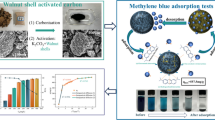Abstract
In the present research, CO2 and SO2 binding ability of different oil shale ashes and the effect of pre-treatment (grinding, preceding calcination) of these ashes on their binding properties and kinetics was studied using thermogravimetric, SEM, X-ray, and energy dispersive X-ray analysis methods. It was shown that at 700 °C, 0.03–0.28 mmol of CO2 or 0.16–0.47 mmol of SO2 was bound by 100 mg of ash in 30 min. Pre-treatment conditions influenced remarkably binding parameters. Grinding decreased CO2 binding capacities, but enhanced SO2 binding in the case of fluidized bed ashes. Grinding of pulverized firing ashes increased binding parameters with both gases. Calcination at higher temperatures decreased binding parameters of both types of ashes with both gases studied. Clarification of this phenomenon was given. Kinetic analysis of the binding process was carried out, mechanism of the reactions and respective kinetic constants were determined. It was shown that the binding process with both gases was controlled by diffusion. Activation energies in the temperature interval of 500–700 °C for CO2 binding with circulating fluidized bed combustion ashes were in the range of 48–82 kJ mol−1, for SO2 binding 43–107 kJ mol−1. The effect of pre-treatment on the kinetic parameters was estimated.




Similar content being viewed by others
References
Ots A. Oil shale combustion technology. Tallinn: SC Estonian Energy; 2004.
Kuusik R, Uibu M, Kirsimäe K. Characterization of oil shale ashes formed at industrial-scale CFBC boilers. Oil Shale. 2005;22:407–19.
Kuusik R, Uibu M, Toom M, Muulmann ML, Kaljuvee T, Trikkel A. Sulphation and carbonization of oil shale CFBC ashes in heterogeneous systems. Oil Shale. 2005;22:421–34.
Kaljuvee T, Toom M, Trikkel A, Kuusik R. Reactivity of oil shale ashes in the binding of SO2. J Therm Anal Calorim. 2007;88:51–8.
Kuusik R, Türn L, Trikkel A, Uibu M. Carbon dioxide binding in the heterogeneous systems formed at combustion of oil shale. 2. Interactions of system components—thermodynamic analysis. Oil Shale. 2002;19:143–60.
Jia L, Anthony EJ. Pacification of FBC ash in a pressurized TGA. Fuel. 2000;79:1109–14.
Anthony EJ, Jia L, Woods J, Roque W, Burwell S. Pacification of high calcic residues using carbon dioxide. Waste Manag. 2000;20:1–13.
Kaljuvee T, Kuusik R, Radin M. Carbon dioxide binding in the heterogeneous systems formed at combustion of oil shale. 4. Reactivity of ashes towards acid gases in the system fly ash—flue gases. Oil Shale. 2004;21:13–26.
Abanades JC. The maximum capture efficiency of CO2 using a carbonation/calcination cycle of CaO/CaCO3. Chem Eng J. 2002;90:303–6.
Lee DK. An apparent kinetic model for the carbonation of calcium oxide by carbon dioxide. Chem Eng J. 2004;100:71–7.
Beruto DT, Vecchiattini R, Giordani M. Solid products and rate-limiting step in the thermal half decomposition of natural dolomite in a CO2(g) atmosphere. Thermochim Acta. 2003;405:183–94.
Salvador C, Lu D, Anthony EJ, Abanades JC. Enhancement of CaO for CO2 capture in an FBC environment. Chem Eng J. 2003;96:187–95.
Chrissafis K. Multicyclic study on the carbonation of CaO using different limestones. J Therm Anal Calorim. 2007;89:525–9.
Stanmore BR, Gilot P. Review—calcination and carbonation of limestone during thermal cycling for CO2 sequestration. Fuel Process Technol. 2005;86:1707–43.
Mohamed AR. Kinetic model for the reaction between SO2 and coal fly ash/CaO/CaSO4 sorbent. J Therm Anal Calorim. 2005;79:691–5.
Kuusik R, Kaljuvee T, Trikkel A, Arro H. Reactivity of oil shale ashes towards sulfur dioxide. 2. Low temperature ashes formed by using CFBC technology. Oil Shale. 1999;16:51–63.
Lee KT, Bhatia S, Mohamed AR, Chu KH. Optimizing the specific surface area of fly ash-based sorbents for flue gas desulfurization. Chemosphere. 2006;62:89–96.
Fernindez J, Renedo MJ, Pesquera A, Irabien JA. Effect of CaSO4 on the structure and use of Ca(OH)2/fly ash sorbents for SO2 removal. Powder Technol. 2001;119:201–5.
Anthony EJ, Bulewicz EM, Jia L. Reactivation of limestone sorbents in FBC for SO2 capture. Prog Energy Combust Sci. 2007;33:171–210.
Trikkel A, Zevenhoven R, Kuusik R. Modelling SO2 capture by Estonian limestones and dolomites. Proc Estonian Acad Sci Chem. 2000;49:53–70.
Kaljuvee T, Trikkel A, Kuusik R. Decarbonization of natural lime-containing materials and reactivity of calcined products towards SO2 and CO2. J Therm Anal Calorim. 2001;64:1229–40.
Crnkovic PM, Milioli FE, Pagliuso JD. Kinetics study of the SO2 sorption by Brazilian dolomite using thermogravimetry. Thermochim Acta. 2006;447:161–6.
Iisa K, Hupa M, Yrjas P. Product layer diffusion in the sulphation of calcium carbonate. Symp (Int) Combust. 1992;24:1349–56.
Kaljuvee T, Trikkel A, Kuusik R, Bender V. The role of MgO in the binding of SO2 by lime-containing materials. J Therm Anal Calorim. 2005;80:591–7.
Reich L, Stivala SS. Computer analysis of non-isothermal TG data for mechanism and activation energy. Part I. Thermochim Acta. 1984;73:165–72.
Kök M, Pokol G, Keskin C, Madarász J, Bagci S. Combustion characteristics of lignite and oil shale samples by thermal analysis techniques. J Therm Anal Calorim. 2004;76:247–54.
Li Y, Qi H, You C, Xu X. Kinetic model of CaO/fly ash sorbent for flue gas desulphurization at moderate temperatures. Fuel. 2007;86:785–92.
Wu ZH, Kou P, Yu ZW. The modulation of desulphurization properties of calcium oxide by alkali carbonates. J Therm Anal Calorim. 2002;67:745–50.
Acknowledgements
This research was supported by Estonian Science Foundation (G7379) and Estonian Ministry of Education and Research (SF0140082s08). Authors express their gratitude to Dr Olga Volobujeva (Tallinn University of Technology) for the help in carrying out SEM and EDX analysis and to Dr Kalle Kirsimäe (Tartu University) for performing quantitative X-ray analysis.
Author information
Authors and Affiliations
Corresponding author
Rights and permissions
About this article
Cite this article
Trikkel, A., Keelmann, M., Kaljuvee, T. et al. CO2 and SO2 uptake by oil shale ashes. J Therm Anal Calorim 99, 763–769 (2010). https://doi.org/10.1007/s10973-009-0423-7
Received:
Accepted:
Published:
Issue Date:
DOI: https://doi.org/10.1007/s10973-009-0423-7




